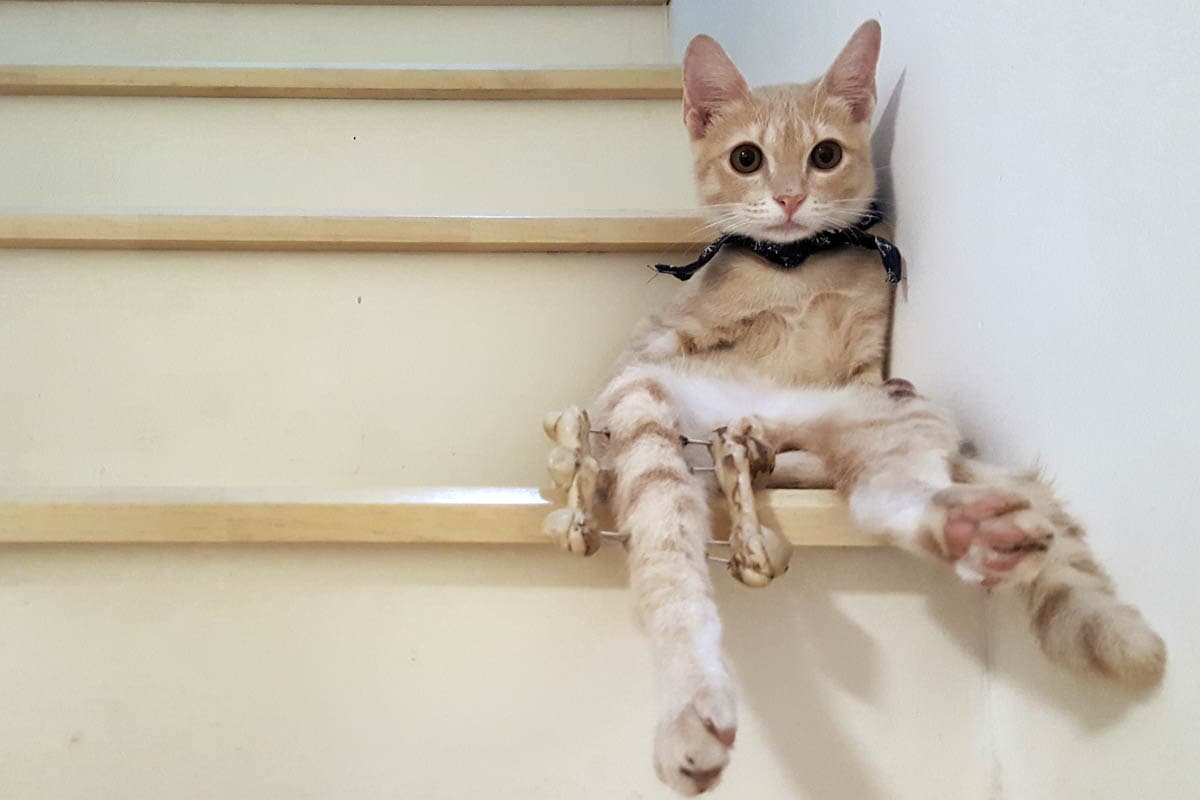Most broken bones which affect cats are due to trauma, such as being hit by a car or a fall from a height. Other causes of broken bones in the leg include bone infection, cancer and hormonal imbalances which weaken the bone.
The most common bone breakages seen in cats is a broken pelvis, broken legs, and broken tail. This article refers to broken legs, for more information on broken pelvis in cats, read here.
Symptoms
Fractures fall into two categories. Closed and open.
- Closed (simple) fracture – The bone remains inside the tissue.
- Open (or compound) fracture – The bone sticks through the skin, this type of fracture poses a significant risk of infection.
Symptoms of a broken leg include the following:
- Reluctance to bear weight on the affected leg
- Limping
- Pain and tenderness
- Swelling
- Protrusion of the bone through the skin (open fracture)
- Deformity or unusual bend in the limb
- Rapid breathing if the injury has just occurred
- Shock
Immediate care
Seek immediate veterinary attention if you suspect your cat has a broken leg. If the veterinarian is some distance away, you will need to immobilise the limb to prevent further injury from occurring.
How to splint a broken leg on a cat:
Closed fracture of the lower limb
- Wrap a piece of cardboard, rolled up newspaper or the centre of a paper towel roll around the limb to make a makeshift splint. Wrap the splint in clean gauze or tape to secure. Make sure the tape/gauze isn’t too tight that it cuts off the circulation. The splint should be long enough to reach the joints above and below the break. When splinting, do not attempt to straighten the leg yourself.
- If a compound fracture has occurred, place a piece of sterile gauze or a sanitary towel immediately over the wound and then splint. Do not try to push the bone back under the skin.
- Wrap the cat in a towel and place him on a rigid surface to transport to the veterinarian.
Open fracture
Do not attempt to splint a leg with an open fracture
- Rinse the area with clean water
- Cover the area with sterile gauze or a clean cloth
- Wrap the cat in a towel and place him on a rigid surface to transport to the veterinarian.
Be aware that a cat in pain may lash out. If you cannot safely splint the leg, transport the cat to the veterinarian. Do not attempt to treat a cat who is resisting as it can cause more harm than good.
Treatment
Cats with fractures will need to be carefully examined by your veterinarian as they may have other injuries such as a broken pelvis, organs, and soft tissue damage (to name a few).
The veterinarian will perform an x-ray to check for breakage and assess the extent of the damage.
Treatment will depend on the nature of the fracture and will require internal or external fixation to stabilise the bone.
External fixation:

- A splint, cast or padded bandage is placed around the leg to immobilise it while it heals.
- External pins and wires are inserted into the bone vertically to support the bone.
Internal fixation:

- Surgery to realign the bones and place screws, pins and, rods into the bone to hold the pieces together while it heals.
In some cases, it may be necessary to amputate the leg.
Home care
It will be necessary to confine the cat to a small area for 4-6 weeks during recovery to allow the bone to heal. A quiet room or if necessary, a crate with a bed, litter tray, and food/water bowls.
If your cat has a bandage on the leg, keep it as clean and dry as possible.
Watch for signs of infection such as pain, swelling and an unpleasant odour.
Follow up x-rays will be necessary to ensure the bone is healing.
Frequently asked questions
Will a cat’s broken leg heal on its own?
This depends on the kind of break, but in general, treatment is necessary to move the broken pieces of bone together and stabilise them to prevent them from moving out of place. Infection is also a risk for fractures that are left untreated. Broken bones are incredibly painful and require analgesics to relieve suffering.
How long does it take for a broken leg to heal?
Greenstick depends on the severity of the break and the age of the cat. Kittens and young cats heal faster than adults. In general, a soft callus should form within the first 1-2 weeks which will be replaced with a hard callus over the following weeks. The entire process takes between 6-8 weeks.
Can a cat still walk on a broken leg?
This is possible if the fracture is minor (such as a greenstick fracture), however, a cat cannot walk on a bone that has snapped.
What can you give the cat for pain relief?
Cats metabolise drugs differently from people. The only painkillers cats can take are veterinary prescribed. Do not attempt to medicate a cat with over the counter or prescription painkillers for humans.
Feature image: Henk Vrieselaar, Shutterstock.

